Be Sure to Look Below
I’ve had four sightings of this issue in the last two months. Although I see this maybe once or twice each year, the frequency I’ve been coming across it recently has me somewhat concerned. I suspect many growers also have this, but may be completely unaware it’s occurring. You can’t see it by looking at the top of your perennials.
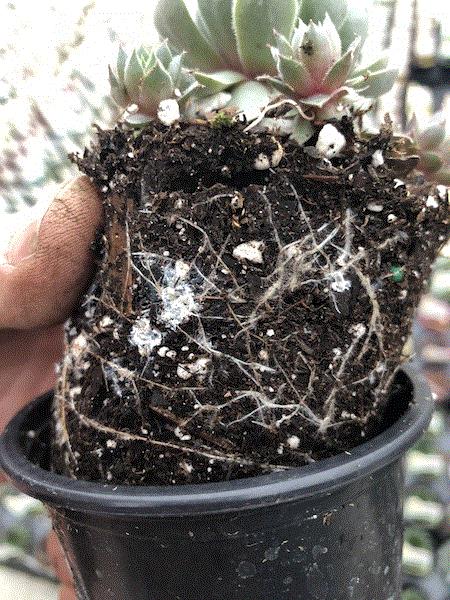
White patches observed in the root zone of sempervivum.
That’s right—it’s time to get your hands dirty and tip out some containers and look at what’s happening below the surface. What are these peculiar white patches that appear to be growing in the root zone? That’s literally a question for you to contemplate as you read this week’s newsletter. I wish you luck and will have the great reveal before signing off.
Upcoming Intros from Terra Nova
Here are a few upcoming Terra Nova Nurseries introductions that stand out to me.
Artemisia Makana Silver
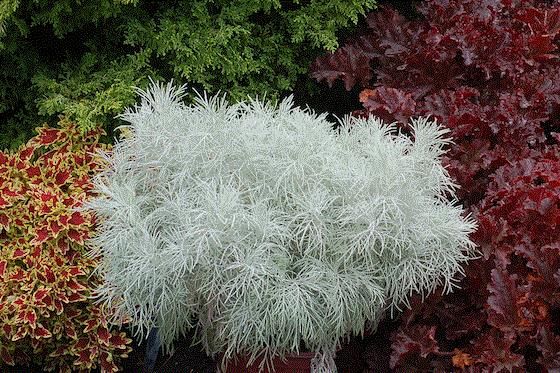
If you’re looking for a new cold hardy artemisia, I’m afraid Makana Silver isn't the plant for you. However, it’s a great perennial for the warmest parts of the country, as its cold hardy in USDA Zones 9 to 11. (I’m sorry if the image got your hopes up, but hang with me just a little longer as I plead my case.)
Makana Silver is fast growing and its soft, silvery foliage makes it a great candidate for mixed containers or, please forgive me, to be used as an annual in the landscape. Regardless, this large 24-in., mounding artemisia has potential for some growers and retailers.
Echinacea Prima Cinnamon and Prima Ginger
Here are two great new colorful echinacea cultivars. The first cultivar, Prima Cinnamon (above left), is a compact (18 in.), well-branched cultivar that produces loads of double cinnamon red flowers. The second I’d like to pass along is Prima Ginger (above right). It's also compact (16 in.) and well branched and produces loads of charming multicolored blooms—they emerge as soft orange and age to a pink tone. Both cultivars are hardy to Zone 4 and would make great additions to your perennial palette.
Heuchera Northern Exposure Purple
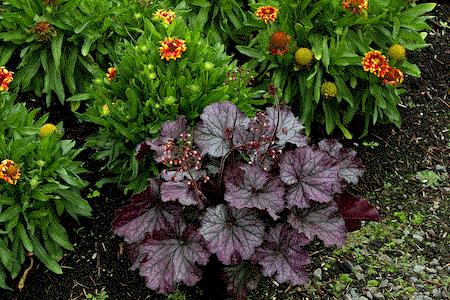
Terra Nova is known for their excellent heuchera introductions and here’s another worthy cultivar for your consideration. Northern Exposure Purple has great purple to silver leaves and with its H. richardsonii bloodline (so to speak), it’s hardy all the way up to Zone 3.
Penstemon Dakota Burgundy
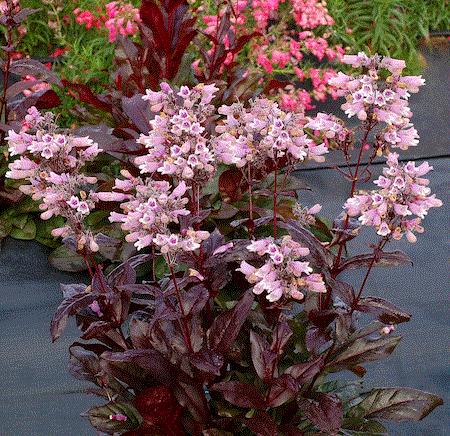
The final Terra Nova introduction I wanted to share is Penstemon Dakota Burgundy. Dakota Burgundy has glossy, purple black leaves and is more compact than the other dark leaf cultivars on the market. It also develops large showy lavender to violet flowers in the early summer. Dakota Burgundy is great for cut flowers, the gardens and hummingbirds love it, too. Hardy to Zone 3.
Consider trying these and click here to check out more of Terra Nova Nurseries' 2018 introductions.

Potential Bare Root Shortage
Here are a couple examples of bare root on display at the Rijnbeek & Son booth at MANTS last month. Hosta Night Before Christmas (left) and Epimedium rubrum (right).
I’ve heard rumblings over the past couple of weeks that, due to excessive rains (about three weeks’ worth) in the Netherlands last fall, there could potentially be some bare root shortages in the near future. I’ve reached out to several bare root suppliers (Darwin Perennial, DeVroomen, Garden World and Rijnbeek & Son) to get a feel for how this adverse weather may impact the supply of bare root starting materials this year.
All of the suppliers were optimistic about the near term and have stockpiled a large amount of bare root into their coolers before the rains even occurred. This means there should be very little disruption to the supply of most perennial bare root items in the near term.
There could be some intermediate effects to crops such as astilbe, dicentra or geraniums, which are more sensitive to excessive moisture. However, even these varieties appear to be only minimally affected if there was any impact at all.
The long-term effects should be fairly minimal, as the rains occurred after the growing season. If the adverse weather would’ve occurred during the growing season, the amount of growth and root size would’ve been reduced. However, this wasn't the case, so the long-term availability appears to be near normal.
Thankfully, the rumors appear to be just that and if you’ve heard anything, it was most likely just shop talk without a lot of substance behind it. The one message that multiple suppliers did convey was to encourage growers to get their orders in early (the earlier the better). It’s also important to look ahead and place future orders as well. If you run across any availability issues, please let me know (ppilon@ballpublishing.com). But in the meantime, get planting and have a great spring!

More than a Perennial Guru

Dr. Allan Armitage (left) and his USTA team celebrate their National tennis victory.
You knew Dr. Allan Armitage was a perennial guru, but did you know Dr. A has game? Not only is he passionate about plants, but apparently he’s a pretty talented tennis player as well. Dr. Armitage played on a USTA tennis team and they recently won the National Tennis Championship for his age group.
Click here to read more about Dr. Armitage’s road to sweet victory. Congrats, Dr. A! You da man!
2018 Year of the Coreopsis
|
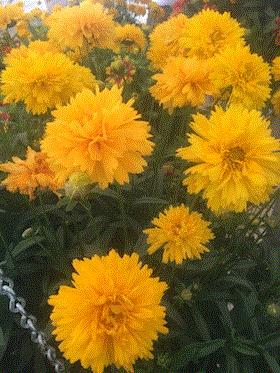
Coreopsis Sunswirl (Dümmen Orange)
|

Coreopsis UpTick Gold & Bronze (Darwin Perennials)
|
The National Garden Bureau (NGB) named 2018 the Year of the Coreopsis. Coreopsis have come a long way over the years; there’s so many bright and cheery colors available. From natural prairie settings to wildflower patches to formal gardens—and let’s not forget that patio planter—coreopsis sure have a way of livening up any location with their bright, colorful flower displays. Originally known for various shades of yellow or gold, the colorful shades of red, bronze, burgundy and other great colors or color combinations many cultivars provide shouldn't be overlooked when deciding which coreopsis would be best for a particular location or purpose.
There are coreopsis suitable for nearly any location, with many of them having hardiness all the way up to Zone 3, as well as a plentiful array of choices for warmer locations as well. A perennial program wouldn’t be the same without this colorful and reliable perennial. Be sure you offer lots of colorful coreopsis and take advantage of the extra publicity and attention this great perennial will be receiving this year.
Visit the NGB website to learn more history and fun facts about coreopsis and to download FREE Coreopsis Fact Sheets and printable signs to help you promote these great plants. Join the National Garden Bureau and make 2018 your Year of the Coreopsis in your garden center and landscape.

Did You Figure It Out?
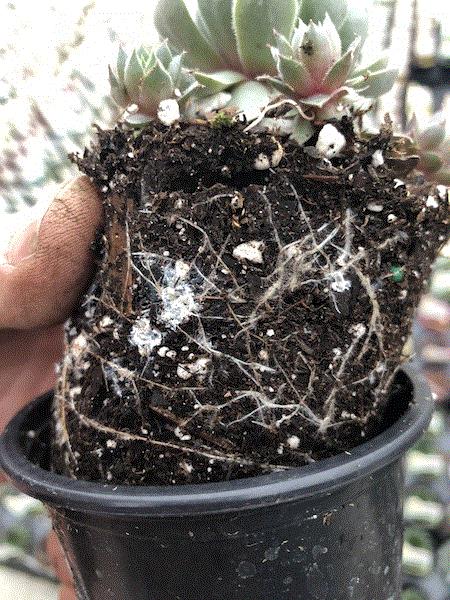
At the beginning of the newsletter, I showed you this image. Since you’ve had some time to ponder your answers while reading all the great content between here and there, it's time for me to ask, “What’s happening here?”
Here’s a closer look from a different plant. Maybe it will help you narrow down your choices ...
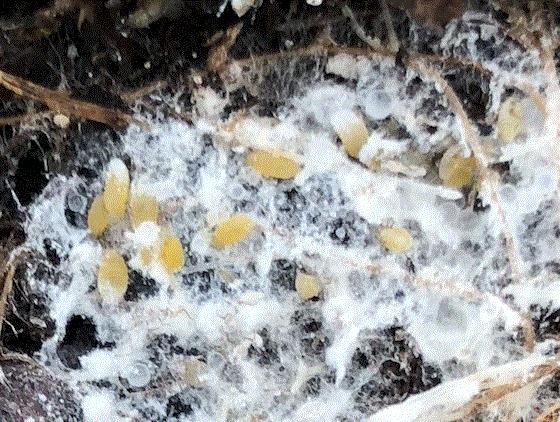
If you guessed Phylloxera, you win a gold star and can take the rest of the day off (ask your supervisor first, I don’t want any disgruntled phone calls). I’d even be happy if your response was root aphids because that’s exactly what Phylloxera are.
Phylloxera is a family of insects that are near cousins of aphids. I’m not sure what constitutes a near cousin, but I do know that root aphids are something you and your customers will probably not want to see. As their common name suggests, root aphids occur below the surface of the soil and in containerized plants or liners. They can most commonly be observed on the outside of the root system.
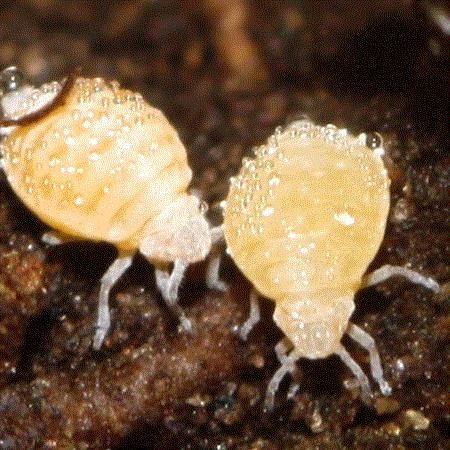
www.planetnatural.com
The first indication you could have root aphids is the presence of white chalky patches on the root ball. These patches are essentially a chalky, waxy type of honeydew they secrete. To solidify they're present, look within the white patches, and if you see one or more pear-shaped, usually light brown bodies about the same size (1 to 2 mm) as the aphids you’re already familiar with—I'm afraid you have root aphids. Like aphids, they're often found in colonies. They typically reproduce asexually during the growing season, but do produce eggs that can overwinter in the soil.
You’re probably wondering how they get there. Quite simply, there's a winged stage that occurs in the fall, when their populations increases or as the food source is dwindling. The adults can be mistaken for fungus gnats.
I’ve most commonly observed root aphids on sempervivum, but have also seen them feeding on iberis and sedum. I’ve even heard of cases of them being on other perennials, such as gaillardia and hosta. If I was in your shoes, I’d definitely check your sempervivum and sedums (perhaps other succulents, too) and if you find them there, expand your search to other perennials.
I’ve not known root aphids to kill plants, but there can be above ground symptoms, including withered or curled leaves, lack of vigor and/or yellowing, which resembles magnesium or iron deficiencies. Regardless, you’ll likely get phone calls from unhappy customers if you don’t control them. Effective drench options include BotaniGard, Grandevo, Kontos, Mainspring, Safari and Talstar. I don’t suspect a single application will give you 100% control, so be prepared to make multiple applications and rotate to another effective product when doing so.

Perennial Replay
No worries if you weren’t able to attend last weeks Perennial Plants for Every Season webinar. You can view the archive of Walters Gardens Trial Manager Jeremy Windemuller as he guides us through how some perennials benefit from being grown during the summer months rather than being planted in the late winter or spring. He discusses which perennials benefit from summer planting, their cultural requirements and how to overwinter them. Click here at your leisure to see this great presentation.
Has your spring about to be sprung? Believe it or not, spring is almost here and with it I'm guessing there'll be a few bumps along the way. Please keep me posted of any surprises that pop up or let me know if there are any topics you'd like me to cover in future newsletters. My email is ppilon@ballpublishing.com.
Thanks for reading this edition of Perennial Pulse.
Paul Pilon
Editor-at-Large
Perennial Pulse
This email was received by you and over 33,516 subscribers!
If you're interested in advertising in Perennial Pulse, contact Kim Brown ASAP and she'll hook you up.